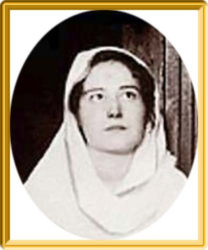Yogananda’s Roaring Editor
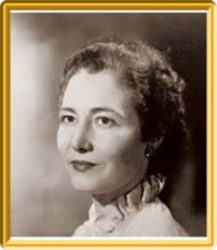
The brilliant editor-in-chief
Yogananda declared that his Autobiography of a Yogi would be his “messenger”. Indeed, through this luminous spiritual classic, his message concerning Kriya Yoga circled the entire globe. Instrumental in this success was a tireless editor who had shaped Yogananda’s imperfect English into linguistic jewels. Her name was Tara Mata, then still known as Laurie Pratt. Yogananda is reported to have said: “She is the best editor in the country; maybe anywhere.”
He expressed his gratitude to her at the very beginning of his famous Autobiography:
“I am deeply indebted to Miss L. V. Pratt for her long editorial labors over the manuscript of this book.”
Her life is quite important for another reason too: if some of those inside the organization are to be believed, Tara Mata contributed decisively to the development of SRF, making it what it is today, through her strong and domineering personality.
Tara Mata was one of the early disciples of Yogananda. She met him in 1924, before he had even established Mount Washington. But who was she? What was she like?
This article might actually go somewhat against her own wishes, as she never wanted the spotlight turned on herself. Not one photo of her can be found in any of the magazines she edited. When Yogananda praised her in public, she asked him to desist, explaining, as Daya Mata recounts, “it pains me when you do so.” But Yogananda continued to do so.
In the 5th and 6th edition of the Autobiography of a Yogi, Tara Mata even deleted Yogananda’s words of gratitude to her quoted above. In later editions, perhaps because of others’ insistence, she restored them. Her desire was to be forgotten altogether after her death. A rare wish indeed.
Her family
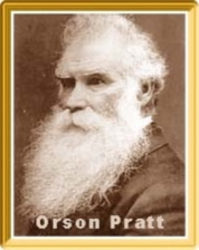 She came from quite a well-known family: her grandfather, Orson Pratt (1811-1881), was one of the founders of the Mormon Church and was an original member of its “Quorum of the Twelve Apostles”. Just as an aside: Orson Pratt’s brother, Parley P. Pratt, also co-founder of the Mormon Church, is the great-grandfather of Governor Mitt Romney, who in 2012 ran for president of the USA.
She came from quite a well-known family: her grandfather, Orson Pratt (1811-1881), was one of the founders of the Mormon Church and was an original member of its “Quorum of the Twelve Apostles”. Just as an aside: Orson Pratt’s brother, Parley P. Pratt, also co-founder of the Mormon Church, is the great-grandfather of Governor Mitt Romney, who in 2012 ran for president of the USA.
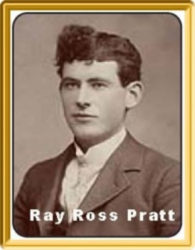 Orson Pratt had 10 wives and 45 children (one wonders whether he was able to remember all their names). One of this clan was Ray Ross Pratt (1871-1945), Tara Mata’s father, who became a professor at Berkeley University in San Francisco and who was a veteran of the Spanish-American War. Her mother was Mulvina Hannah MacLeod (1880-1938). Tara Mata’s parents divorced in early 1920 when she was 19 years old.
Orson Pratt had 10 wives and 45 children (one wonders whether he was able to remember all their names). One of this clan was Ray Ross Pratt (1871-1945), Tara Mata’s father, who became a professor at Berkeley University in San Francisco and who was a veteran of the Spanish-American War. Her mother was Mulvina Hannah MacLeod (1880-1938). Tara Mata’s parents divorced in early 1920 when she was 19 years old.
Tara Mata was born on August 16, 1900 in San Francisco. She had an elder brother, Ross MacLeod (1899-1964), and a younger sister, Jessie Margaret Pratt (1903-1971).
At the age of 19, Tara Mata went to study at Berkeley, where her father taught. In an article by (published by Sidney D. Kirkpatrick on June 9, 2017 in https://www.edgarcayce.org), Tara Mata is described as “a fiercely independent thinker.” Her free-thinking mind couldn’t be contained or controlled by her knowledgeable father, or by the teachings of the Mormon Church.
Tara Mata’s soul-quest
But behind her strong, brilliant and indomitable mind there lay hidden another, deeper reality: her soul’s painful awareness of the fact that, without coming to know God, life will be forever empty.
During those youthful years, she became acquainted with India’s ancient spiritual tradition, which, as Daya Mata tells, “seemed to have awakened in her memories of previous lives, steeped in the knowledge and wisdom of that holy land.” The effect was strong. Her soul became profoundly restless in its desire to find the Eternal Solace.
Tara Mata was, from all accounts, an extremely beautiful young woman. Beauty, however, meant nothing to her anymore. She yearned for something else.
The best way to gain some insight into her soul and her spiritual agonies during those early years is through a booklet which Tara Mata herself wrote: Forerunners of a New Race. In it she describes a man in spiritual despair who met Yogananda and through that meeting became completely transformed. SRF confirms that Tara Mata was indeed describing herself: the text is autobiographical.
From this booklet we get a clear glimpse of Tara Mata’s dire inner state. She “possessed intense religious faith and aspiration”, and was “well read in the sacred scriptures of the world”, but she “knew that this intellectual knowledge… did not feed the soul-hunger” within her. Consequently, “there yawned a black abyss of despair” over her days. It was the despair that she wasn’t “worthy of any direct contact with God, since no such experience was given” to her. This conviction struck at the very roots of her life and “made it seem a worthless and meaningless thing.”
Tara Mata’s plan was, therefore, to finish her studies and then leave for India, where she hoped to quench her relentless soul-thirst.
Meeting Yogananda
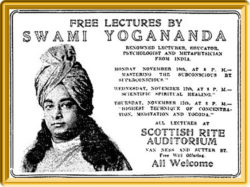 But God had a different plan for her. “Into this dark night of [her] soul came the light of Yogoda.” This divinely planned turning point in her life occurred in November 1924, when Yogananda, aged only 31, visited San Francisco to give lectures. He spoke at the Scottish Rite Auditorium, as he had done previously. A publicity notice is shown on the left.
But God had a different plan for her. “Into this dark night of [her] soul came the light of Yogoda.” This divinely planned turning point in her life occurred in November 1924, when Yogananda, aged only 31, visited San Francisco to give lectures. He spoke at the Scottish Rite Auditorium, as he had done previously. A publicity notice is shown on the left.
What happened during that first meeting was extraordinary. Tara Mata describes it in that same booklet: the “man” (herself), on meeting Yogananda, entered into a state of Cosmic Consciousness. Tara Mata had an experience of ecstasy.
Here are some excerpts from the booklet: “… a man who, as soon as he had heard the Yogoda message, was swept up into Cosmic Consciousness…. The flood-gates of joy broke in his soul; he was inundated with waves of indescribable ecstasy. Words that had been merely words to him before—bliss, immortality, eternity, truth, divine love—became, in the twinkling of an eye, the core of his being, the essence of his life, the only possible reality…. The sublime splendor and joy of this discovery were so vast that he felt that centuries, millenniums, countless eons of suffering were as nothing, as less than nothing, if by such means this bliss could be obtained. Sin, sorrow, death—these were but words now, words without meaning, words swallowed up by joy as minnows by the seven seas.”
It should be added here that Tara Mata did not suffer from low self-esteem. She writes that this man was “the only man of true Illumination, outside of Swami Yogananda, whom I have known personally, though I have heard or read of a number of other Yogoda students who have had a more or less similar experience.”
In other words, Tara Mata regarded herself as the most highly advanced disciple of Yogananda at that time, higher than Dr. Lewis, higher than Gyanamata (who had also had met Yogananda in 1924) and others too.
Her soul and “fiercely independent” nature now bowed before the Master, Yogananda. She was 24. Instead of leaving for India, she knew that “The India that I was seeking has come to me.”
As all close disciples of Yogananda, she was a highly evolved yogi. In fact, Yogananda said of Tara Mata: “She is a great yogi…who lived many lives hidden away from the world in India. She has come in this life to serve this work, as did many of you who have lived other lives in India. God has brought you all here to help me spread the message of Kriya Yoga.”
Life with Yogananda
From then on Tara Mata followed Yogananda, accompanying him on his “campaigns” throughout America and even to Cuba and Alaska (see the article by Daya Mata, SRF Magazine, Oct.1971). What a rare blessing.
In 1925, Yogananda started his magazine with the valuable editorial support of Tara Mata (still called Laurie Pratt). In the same year, together with Yogananda, she moved into the newly-acquired Mount Washington headquarters. It was a simple, beautiful life, devoted to the Yogoda message, to the liberating teachings of Self-realization and to Kriya Yoga.
She made friends with Clara Clemens, the daughter of Mark Twain, who, in 1926, had become a student of Yogananda.
Departure from SRF
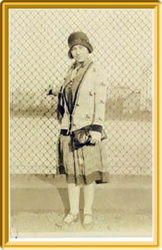 But the spiritual path is a rocky one for everyone. Tales of disciples with unwavering devotion, who never stumble on the path, are simply unreal. Karma makes its appearance again and again even in great souls like Tara Mata. In 1927, she became friends with the famous clairvoyant Edgar Cayce. His readings for her can be found in the files of his organization. They make it clear that Tara Mata had become uncertain of her vocation: “Pratt was present in Virginia Beach on June 11, 1927, for the first of two life readings she would receive (778-1 and 778-2). Many questions for which she desired counsel regarded her vocation.”
But the spiritual path is a rocky one for everyone. Tales of disciples with unwavering devotion, who never stumble on the path, are simply unreal. Karma makes its appearance again and again even in great souls like Tara Mata. In 1927, she became friends with the famous clairvoyant Edgar Cayce. His readings for her can be found in the files of his organization. They make it clear that Tara Mata had become uncertain of her vocation: “Pratt was present in Virginia Beach on June 11, 1927, for the first of two life readings she would receive (778-1 and 778-2). Many questions for which she desired counsel regarded her vocation.”
Of what nature were the doubts that troubled her? Perhaps they were connected with the fact that she was an enthusiastic astrologer, but was almost unable to follow this passion within SRF. Yogananda, as Daya Mata recounts, counseled her not to practice astrology. At any rate, there wasn’t much time for it: she had a very busy life, filled with editorial service. But it seems that the real karmic vortex concerned marriage.
Yogananda, it seems, had sensed that this karma would arise. In Conversations with Yogananda, Swami Kriyananda writes about an exchange he once had with Tara Mata, “who was for some time one of my dearest friends.” She told him: “You know, in the early days, in the 1920s, Master didn’t talk about creating a monastery. One day I entered his study to find him smiling broadly. ‘Would you like to be married?’ he asked. I hadn’t thought about this possibility, and wasn’t particularly interested in it. As things turned out, however, I did get married later on. Maybe he was seeing marriage in my karma. At any rate, he certainly didn’t indicate to me that he was opposed to my marrying.” Swami Kriyananda concludes: “To me (Walter) the Master said regarding her, ‘She was never touched, inwardly, by that experience.’”
In fact, in 1929 she left Yogananda and Mount Washington, to marry. Her husband Mr. Reginald Carmody was a salesman, who had decided to study law. The couple moved to Atlanta, where she conceived a daughter, Mauna Carmody (sometimes written Mona, probably because otherwise it is easily mispronounced). In 1955 Mauna (June 28, 1930-July 6, 1991) married Donald Siegel in San Francisco and in 1966 she conceived a son, Robert Allen Florez. Tara Mata had only four years of her life left to enjoy her grandson.
Sidney D. Kirkpatrick in his article about Tara Mata states that she was the breadwinner of the family thanks to her astrology readings and it was she who put her husband through his studies. She now dedicated her life to her new family and to horoscopes. Tara Mata joined the Cayce association, lecturing at their 1933 Congress. In addition to all this, she still contributed to Yogananda’s work: for his East-West magazine she wrote articles on Astrological World Cycles, discussing Sri Yukteswar’s yuga system. She also wrote an essay called Shankara, the great Vedantist. In Yogananda’s East-West magazine, March 1934, one finds an add of Laurie Pratt as an astrologer in Atlanta, and later several adds for her Yuga book, published outside of SRF.
The 1936 Nevada State Journal, Reno, NV May 6, 1936, contains the announcement of her divorce. In other words, her marriage did not last long. “Do you want me to worship my mistakes?” she was reported to have said. Indeed, her marriage had taken her away from her divine Master for seven years.
Back with Yogananda
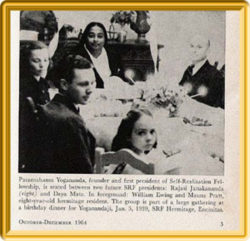 In late 1936, Yogananda arrived back on American shores, returning from his long visit to India. He must have heard of Tara’s divorce. At any rate, Durga Mata writes how the Master, even before returning to Mount Washington, went straight to San Francisco, to try to convince Tara Mata to return to SRF and to work on his books. She did. Now finally she was back. Her darling daughter, only six years old, came with her. On the left, there is a beautiful picture (SRF magazine, 1964) of little Mauna at Mount Washington, sitting with Yogananda, Rajasi (as the name was written then), and Daya Mata.
In late 1936, Yogananda arrived back on American shores, returning from his long visit to India. He must have heard of Tara’s divorce. At any rate, Durga Mata writes how the Master, even before returning to Mount Washington, went straight to San Francisco, to try to convince Tara Mata to return to SRF and to work on his books. She did. Now finally she was back. Her darling daughter, only six years old, came with her. On the left, there is a beautiful picture (SRF magazine, 1964) of little Mauna at Mount Washington, sitting with Yogananda, Rajasi (as the name was written then), and Daya Mata.
Tara was enthusiastic about working on the Autobiography of a Yogi, but also on Yogananda’s commentaries on the Bhagavad Gita and the Bible. In 1937, she wrote in a letter: “He gets it entirely from inspiration. In fact, it is only through him that I know what ‘inspired books’ really means. He will come to a passage which is so obscure that it defies all possibility of plain interpretation. He will look blankly at me or one of his other secretaries for a while, close his eyes, and presently out will come the whole plain meaning. I tell you it has been an education and a privilege to help with this wonderful book. My end is pure grammar, arrangement, etc. None of the interpretation is anyone’s but Swamiji’s.”
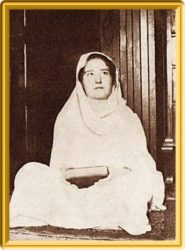 In 1937, she took monastic vows. This seems a revolutionary act on Yogananda’s part: Tara Mata became a nun while being the mother of a small daughter. Rajarsi Janakananda similarly took monastic vows while his wife was still alive. They were “family renunciants”.
In 1937, she took monastic vows. This seems a revolutionary act on Yogananda’s part: Tara Mata became a nun while being the mother of a small daughter. Rajarsi Janakananda similarly took monastic vows while his wife was still alive. They were “family renunciants”.
The old samsksars surfaced again in Tara Mata: after her marriage, she returned to the life of a hermit. Daya Mata describes this leaning of hers in the following words: “She had no attachment to, nor felt any need for, the company of other human beings.” Fellow devotees might not have felt much human love from her. Tara Mata herself explains: “Many will think that because I stay away from people I don’t love them. But I remain apart because I know I am here for one reason: to devote my life to Guruji’s work and to use whatever powers God has given me to serve it. My life is dedicated to that ideal.”
The hermit
Interestingly, Tara Mata, the hermit, didn’t actually live at Mount Washington. At times she lived near Yogananda’s retreat at Twenty-Nine Palms and she otherwise had her own little house across the valley, where she lived with Mauna. 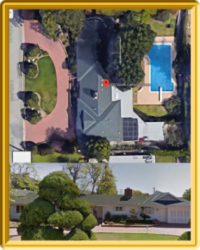 Almost all communication with others took place by telephone.
Almost all communication with others took place by telephone.
Nor did Daya Mata live at Mount Washington after a time. Unknown to most monastics, SRF members, and the worldwide public, she and her sister, Ananda Mata, lived from 1968 until the end of their lives in a comfortable house with swimming pool, 15 miles away, at 200 S Cañon Ave, Sierra Madre. To the right there are two google photos of their beautiful residence.
Tara’s dwelling, one imagines, must have been a bit more humble. Her tastes were simple. In fact, official data give 2800 Prewett Street, Los Angeles, as her last residence. On the left is a google photo which shows the simple small house at that address, 3 miles away from the SRF headquarters.
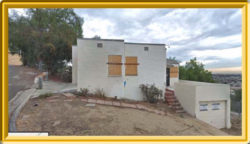
The Autobiography of a Yogi
At the beginning of 1940, Yogananda began to fully concentrate on his Autobiography, staying at the Encinitas hermitage. Tara Mata was with him then, assisting him, together with Daya Mata, Ananda Mata, and Shraddha Mata. He dictated, Daya Mata and the others typed, and the text was then given to Tara Mata for editing.
In 1945 the book was finally finished. It became Tara Mata’s responsibility to find a publishing house for it. The task was far from easy. She took the manuscript to New York, where she selflessly stayed for one year away from the ashram, away from the Guru, alone in an unheated apartment, with only cold water, while trying to find a willing publishing house. She was repeatedly turned down. But finally success was achieved. She found the Philosophical Library, which first published Yogananda’s spiritual Masterpiece.
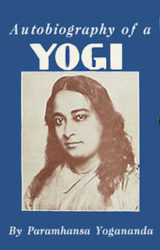 In December 1946, Yogananda’s “spiritual ambassador” saw the light of day. The celebration was great and Tara Mata was at the center of it.
In December 1946, Yogananda’s “spiritual ambassador” saw the light of day. The celebration was great and Tara Mata was at the center of it.
Yogananda’s praise for her, naturally, was boundless. He said: “What Miss Pratt has done for this book I cannot begin to describe… But for her, the book would never have gone through… She has martyred herself for this work.”
Meanwhile, Yogananda kept publishing articles on the Bhagavad Gita and the Bible, all of which Tara Mata edited.
After March 1952
Tara Mata’s principal life work was editing Yogananda’s Autobiography of a Yogi. Indeed, even after his passing, she edited and continued to edit it, making changes to the fifth and sixth editions, countless more to the seventh, and many more again to the eight. Did she go too far? Did the book eventually take on an organizational flavor which Yogananda hadn’t actually given it? This question has since been a point of discussion. Over a thousand changes (without exaggeration) occurred following the third edition of 1951, the last one to be published during Yogananda’s lifetime. Were they all truly wanted by him?
At any rate, after Rajarsi’s passing, Tara Mata was offered the presidency of SRF, as was Durga Mata; both of them being senior disciples. Both declined. Durga Mata writes in her book Triology of Divine Love: “Master had written in SRF by-laws that the Board of Directors would elect the third SRF President.” This is how Durga Mata describes that moment, right after Rajarsi had left the body on February 20, 1955:
“After we left Forest Lawn, Daya had an appointment to keep. Mataji [Ananda Mata], Tara and others came along. They did not want me to go directly to Mt. Washington, but go with them on a little drive. Now I know why. Tara is so seldom with us, they thought we had better take this opportunity to ask me what they wanted her to approach me with, while Daya was at her appointment. Tara took me aside and said, ‘Now that Rajasi is gone, we will have to appoint another president. I spoke to Daya and she felt we should ask you first because you are the eldest sister. What do you say?’ I very positively answered, ‘I wouldn’t burden SRF with another unhealthy president, for Master has told me my life too is in danger, as much as his and Rajasi’s were, and it would be bad for SRF. I honestly believe that Daya would make a far better president than I.’”
So Daya Mata was elected president. As one can see from the above words, however, Tara Mata had a major influence on internal affairs, and her input was highly respected. She was on the Board of Directors, and while unknown to the public, she effectively began to codirect SRF. In fact once she told Swami Kriyananda: “People say that Daya and I run the organization. Well, it’s true. We do.” Theirs was the Mormon style: proper rules, orderly regulations and sensible restrictions.
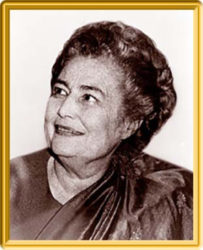 Tara Mata worked intensely and tirelessly. But why, one wonders, if she dedicated her whole life to Yogananda’s service, did his commentaries on the Bhagavad Gita, the Bible, the Rubaiyat and many other works never get to the printing press or get published as books? Granted, these are not small works, but on the other hand she had entire decades to work on them from 1924 to1971. Editing takes time, but not that much time. In the preface to God Talks With Arjuna, Daya Mata points out that Tara Mata was able to publish the articles on the Bhagavad Gita in the SRF magazine, but was unable to complete the preparation of the Gita manuscript, having “many time-consuming duties as member and officer of the Board of Directors and editor-in-chief of all SRF publications.” In fact, as we said earlier, after Yogananda’s passing, together with Daya Mata, she effectively ran SRF.
Tara Mata worked intensely and tirelessly. But why, one wonders, if she dedicated her whole life to Yogananda’s service, did his commentaries on the Bhagavad Gita, the Bible, the Rubaiyat and many other works never get to the printing press or get published as books? Granted, these are not small works, but on the other hand she had entire decades to work on them from 1924 to1971. Editing takes time, but not that much time. In the preface to God Talks With Arjuna, Daya Mata points out that Tara Mata was able to publish the articles on the Bhagavad Gita in the SRF magazine, but was unable to complete the preparation of the Gita manuscript, having “many time-consuming duties as member and officer of the Board of Directors and editor-in-chief of all SRF publications.” In fact, as we said earlier, after Yogananda’s passing, together with Daya Mata, she effectively ran SRF.
Nowadays, Tara Mata is officially described as having been the SRF Vice-President from 1960-1966. This is not quite correct. Swami Kriyananda held that position from 1960-1962, but was later erased from the picture as if he had never existed.
What happened is as follows: Dr. Lewis, the SRF Vice President, died in 1960. Swami Kriyananda writes: “I was voted into his place on the Board of Directors and as the first vice president. It was Tara Mata who proposed the appointment.” This might sound amazing to many people now. But she obviously saw great qualities in Swami Kriyananda. In fact, in the SRF magazine, she wrote, with some praise, that he was close to Yogananda. However, by 1962, her positive attitude towards him had become completely negative.
And, of course, she felt herself in a much superior position to that of the young Kriyananda. When he was Vice-President, she wrote him a note, which still exists today: “Salutations to the first vice-president of SRF, from the second SRF president.” That was precisely how she saw herself.
Tara Mata’s personality
Tara Mata’s loyalty to Yogananda’s work was immense. Daya Mata recollects: “The quality of loyalty she had to a degree I have seen in few human beings.” It was a fierce loyalty, which made her work incessantly and attack all those whom she regarded as disloyal. Daya Mata in fact compared her to the famous “El Cid”, calling her “a warrior indeed.” Tara said of herself: “Once I put my mind upon it [any obstruction to her Master’s mission] and get into the battle, beware!”
Tara Mata didn’t see her service in terms of expansion of Yogananda’s work, trying to lovingly reach, touch, and nurture thirsty souls everywhere. Her focus was rather on keeping the teachings pure and strengthening the core of the organization. “Every work,” she said, “must have a guideline. Our own must be to ask ourselves in every situation, ‘What is best for the work?’”.
Her manner didn’t make it easy for people to love her, it seems. Daya Mata in her memorial talk explains: “Because hers was a fiery nature, she was often misunderstood; but those who knew her loved her deeply, and found her to be wise, loving, tender, and faithful, both as a disciple of guru and as a friend. She was fiery in carrying the torch of Paramahansaji’s teachings, fiery in defending them against those who would harm, fiery in her loyalty, once given.” And she adds: “it is difficult to describe this disciple, now known as Tara Mata.” Hers’ was not a normal, or easy, nature. She was certainly an extraordinary being.
In that same talk, Daya Mata makes a rather unusual statement for an SRF publication, in which the early disciples of Yogananda are usually described in nothing but glowing terms. She quotes Yogananda who said: “She [Tara Mata] is a genius and also has some of the flaws of a genius.” What flaws was he referring to?
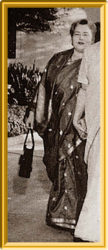 Studying her life, a two-sided picture emerges. On one side she was a truly remarkable character, a genius, both spiritually and intellectually. Yogananda is reported to have said: “She is a genius… Excepting Sri Yukteswar, there is no one with whom I have more enjoyed talking of wisdom and philosophy than my Laurie.” This is high praise indeed. Swami Kriyananda described Tara Mata in similar terms: “In many ways she was a genius.”
Studying her life, a two-sided picture emerges. On one side she was a truly remarkable character, a genius, both spiritually and intellectually. Yogananda is reported to have said: “She is a genius… Excepting Sri Yukteswar, there is no one with whom I have more enjoyed talking of wisdom and philosophy than my Laurie.” This is high praise indeed. Swami Kriyananda described Tara Mata in similar terms: “In many ways she was a genius.”
On the other side she was a ferocious lion with sharp teeth, capable of mercilessly devouring its prey if provoked. Again, Yogananda is reported to have said: “Laurie is like a child: without guile; innocent, trusting, loving. But once she begins to see deviousness in anyone toward Self-Realization Fellowship, watch out! She is like a lion roaring.” Swami Kriyananda reports that the Master also counseled Daya Mata: “Keep her away from people.”
In A Place Called Ananda, Kriyananda describes the same two sides of Tara Mata, how she was quite different inwardly from the way she appeared outwardly: “Tara had a tender nature, inwardly. Few people saw that side of her, however. She was like certain fruits: soft and sweet on the inside, rough on the outside. Most people saw only the outside of Tara, and were put off by her. As for me, I must say that I very much liked her. Her caustic speech I found stimulating; I saw in it an expression of the delight she took in using words colorfully.”
She herself is reported to have said, “I’ve come to realize that those who are against me are against Master. And that means, they are against God.” People who opposed her own view were put into that category and soon came to experience her fiery speech. That was not a small thing, to put it mildly. Swami Kriyananda explained: “For those of you who never met Tara, you simply cannot imagine the power of her will!” When she attacked, she showed no empathy: for her it was a black and white situation, a time for the roaring warrior.
The way she treated Swami Kriyananda is an example of this second side of her nature. The aggressive words she hurled at him can only be described as inhuman: “We don’t want you ever to lecture again in public. We don’t want people to know Master ever had such a despicable disciple.” “You’d stop at nothing short of murder to get what you want! Nothing … short … of murder!” And: “From now on we want to forget that you ever lived.”
Sister Savitri (Heidi Hall) joined SRF in 1970, not long before Tara Mata died, becoming Daya Matter’s personal secretary and a member of the SRF Board of Directors. She knew everything that had happened, and had read all the files concerning Kriyananda. When she later left SRF, she visited Ananda, and stated the obvious: “No one should treat another human being the way Kriyananda was treated.”
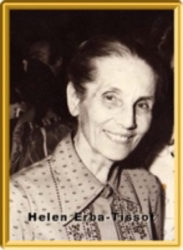 He was not the only one to have experienced this extreme side of Tara Mata. For example, the leader of the SRF work in Europe, Mme. Helen Erba-Tissot (see photo), who had met Yogananda a few days before his mahasamadhi and had been single-handedly spreading Yogananda’s teachings in France, Switzerland, Germany, Austria, and Italy, was also summarily dismissed by her. Some considered it a major setback for Yogananda’s work.
He was not the only one to have experienced this extreme side of Tara Mata. For example, the leader of the SRF work in Europe, Mme. Helen Erba-Tissot (see photo), who had met Yogananda a few days before his mahasamadhi and had been single-handedly spreading Yogananda’s teachings in France, Switzerland, Germany, Austria, and Italy, was also summarily dismissed by her. Some considered it a major setback for Yogananda’s work.
In short: Tara Mata was an extraordinary soul. Her legacy is extremely important, more so than is generally known. On the one hand, her actions and personality shaped SRF significantly. On the other, it led to the creation of Ananda: Yogananda’s community movement came about as a direct result of her fiery nature. Kriyananda explained: “Master knew I was so loyal, nothing less drastic would have worked.” Yogananda wanted to establish such colonies, but SRF in 1960 deleted his wish from his Aims and Ideals. The Master had told Swami Kriyananda repeatedly, “You have a great work to do.” Tara Mata’s fiery nature, therefore, acted as an important catalyst for Yogananda’s mission.
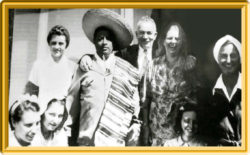 In short: Tara Mata was forever “on fire” for her Master, at whose feet she was sitting, and to whom she had dedicated her entire life, seeking union with God. To the right we see a rare and playful picture of them. Front row, sitting, left to right: Daya Mata, Tara Mata, to the right Mauna (Tara’s daughter). Standing, left to right: Meera Mata (Mrinalini Mata’s mother), Yogananda, Dr. and Mrs. Lewis, Durga Mata.
In short: Tara Mata was forever “on fire” for her Master, at whose feet she was sitting, and to whom she had dedicated her entire life, seeking union with God. To the right we see a rare and playful picture of them. Front row, sitting, left to right: Daya Mata, Tara Mata, to the right Mauna (Tara’s daughter). Standing, left to right: Meera Mata (Mrinalini Mata’s mother), Yogananda, Dr. and Mrs. Lewis, Durga Mata.
Moral
What can we learn from Tara Mata’s colorful life story? For those of us with medium or low energy, the very thought of her presence is a wakeup call for high energy, spiritual passion, and fiery dedication. Greatness is higher than mediocrity, even if that greatness includes flaws that are outstanding. And people whose lives lack energy and driving force, may seem more virtuous than they really are simply because they haven’t the energy to appear otherwise.
On the other hand, those of us who do have a strong will and therefore high energy, let’s contemplate this important teaching: “The Master told us that when he first came to Sri Yukteswar’s ashram, he would keep his mind and gaze focused at the point between the eyebrows as much as possible. ‘If you want to make very rapid progress on the spiritual path,’ he used to tell us, ‘keep your mind always centered there.’ This practice must be joined to, however, and supported by the heart’s devotion. For concentration at the spiritual eye, which is known as the ajna chakra, develops great will power, but it can also make one ruthless if it isn’t combined with the heart’s love. When will power is combined with love, great joy is the consequence.” (Conversations with Yogananda)
Her passing
Yogananda had told Daya Mata: “I am very worried about Laurie. Her health will not permit her to finish the work on my writings.” He therefore trained Mrinalini Mata to finish the remaining editorial work.
Indeed, in 1968, Tara Mata suffered a massive stroke. Brother Turiyananda of SRF reported to Swami Kriyananda that she had said: “I know this happened to me to teach me compassion.” She died two years after that at the age of 70, on January 18, 1971.
Her last moments were inspiring: she gazed for a long time at Yogananda’s picture. Her devotion was total in life and in death. Then quietly and peacefully she closed her eyes and left for the higher worlds.
Tara Mata’s attitude of uncompromising, unyielding discipleship is inspiring. She had told Daya Mata and the others a few years before her passing: “When I leave this body, I want to go quietly. I don’t want any funeral service. I want to be forgotten by the world. There is no need for me to be remembered.”
She had a second wish: half her ashes should be brought to India, and strewn in the holy Ganges. Her wish was fulfilled. The other half is buried in Forest Lawn, Glendale, where Yogananda’s body rests.
In life and death, Tara Mata was extraordinary. And yes, she will be remembered.
The Master is reported to have uttered these amazing words: “It is not necessary for her to meditate in this life. By editing my writings, and because she came here a highly realized soul, she does not require this. I have already set her place for her in heaven.” Now Tara Mata has entered heaven, lovingly welcomed by Yogananda.
Her future incarnation
There is a document written by either Durga Mata or Ananda Mata, dated March 27, 1937, which describes Yogananda’s predictions of the next incarnation of several disciples, one of them Tara Mata. Here is an excerpt:
“Next life, these two people (Margaret Lancaster and Laurie Pratt) will be boys. Next life we will be in the Himalayas and will come with tremendous powers. They (Margaret and Laurie) will be born in India – Laurie in Bengal and Margaret in Punjab. Their parents will try to hold them, and get Margaret married, but she will show the love of God and leave. Laurie will come earlier to the hermitage…. Faye [Daya Mata] will be a boy too…We will pass life in greatest devotion to God, singing praise to Him, with Him appearing to us. And after, when the will of God will go out, we will spread his message again…. Babaji and Lahiri Mahasaya will be there too. My Master [Sri Yukteswar] will come occasionally there. Pranabananda Swami will be there too. Durga will be a Bengali…. The features of all of them will be more or less the same as now, so that if we should leave pictures or statues of ourselves in this life, in the next lives we would recognize ourselves. I [Yogananda] will be several years in contact with God and just roaming singly, and then, when God’s mercy will come, you will all come…. Sister Gyanamata and a few others will be there too. She will be a boy also…”
You may read the full document of Yogananda’s next incarnation.
That next incarnation, Yogananda said, will occur 200 years after his passing, meaning around 2150AD.
